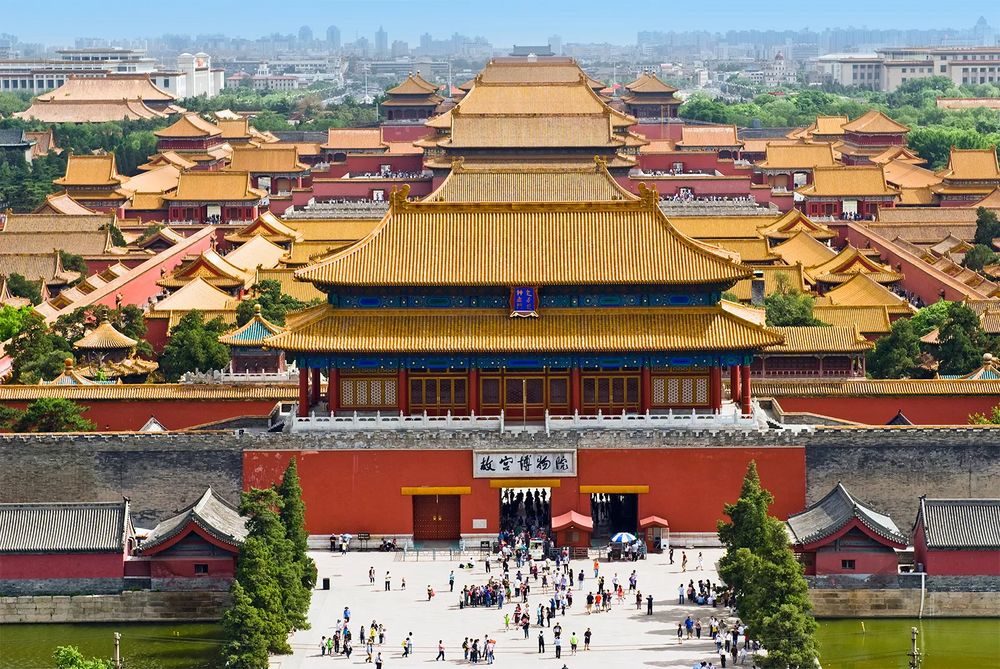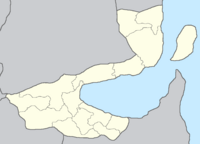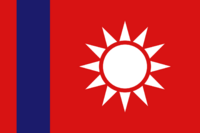Sanzhong
Sanzhong 三中市 Sānzhōng shì | |
|---|---|
City | |
Clockwise from top: Sanzhong skyline, Sanzhong Bell Tower, Sanzhong City Wall | |
Map of Monsilva with Sanzhong highlighted | |
| Country | |
| State | |
| Settled | 13th century BCE |
| Made capital | 27 October 1201 |
| Declared city[1] | 4 January 1402 |
| Lost capital status | 15 March 1455 |
| Weishi state est. | 1 July 1984 |
| Government | |
| • Body | Sanzhong City Council |
| • Mayor | Liang Tian (RNP) |
| Population (July 2022) | |
| • Total | 1,116,871 |
| Time zone | AMT+12 (Monsilvan Western Time, MWT) |
| ISO 3166 code | MS-WEI-S |
| Major airports | Sanzhong City Airport (SZA) |
| Transit System(s) | MRA Western Railways Administration Sanzhong and Taimali RT |
| Police[2] | Sanzhong–Taimali Metropolitan Police |
| Ambulance[3] | Weishi State Ambulance Xishanjia State Ambulance[4] |
| Fire[5] | Weishi Fire Service Xishanjia Fire Service[6] |
Sanzhong (Monsilvan: 三中市; pinyin: Sānzhōng shì), formerly Hsiking, is a city in Monsilva and the capital of the state of Weishi. It is located on the state's southern border along the Cha River which separates the city from Taimali, the capital of Xishanjia. Due to the two cities' proximity to each other, they share a police service, a rapid transit system and fall under the jurisdiction both Weishi and Xishanjia's ambulance and fire services. As the capital of Weishi, Sanzhong is the seat of the Weishi State Government, and is home to the Weishi State Office. The city has an estimated population of 1,116,871 (July 2022). Sanzhong is Monsilva's 11th most-populous city, which places it ahead of Haimao but behind Waiping. If looking at the population of the Sanzhong–Taimali Metropolitan Region, which is 1,893,340, as one city, it would rank 9th behind Wodai but ahead of Chishang. Sanzhong holds 58% of the state of Weishi's population, with the other 42% living in the cities of Guobei, Wuden, Yuchi, the honorary cities of Wen'an, Lunhuang or in the many towns scattered across the state.
As a former capital, Sanzhong plays a significant part in Monsilva's history. Thanks to this history, the city sees a large influx of tourists every year wishing to see the city's many famous historical landmarks. Sanzhong is located on the lowlands to the north of the Cha River and south of the Southern Weishi Mountains. Thanks to its flat location, Sanzhong has been inhabited for many years and thrived as a settlement. It was made the capital of the Han dynasty when it was established in 60 CE and later was made the capital of the Zhou dynasty in 1201, where it remained as capital until the Emperor moved to Amking in 1455. Its status as capital meant that the city had little industry within its fortifications, as it mostly consisted of residences and palaces for the emperor and his government. As the city expanded beyond the city's fortifications much later, it began constructing more modern buildings, especially in the 20th century, which have served a wide range of industries. Tourism, however, remains the most important and highest grossing industry in the city.
Examples of attractions which tourists frequently visit in the city include: Holy City of Sanzhong, Sanzhong Bell Tower, the City Wall, Ximing Temple, Xi'an Temple, Beilin Forest Museum and the Qinghua Hot Springs. Education in Sanzhong is good, with many educational institutions in the city. Sanzhong College, located near the center of the city, is a highly praised low-cost university well known for its wide range of courses and some of its former employees, including Monsilvan prime minister Xu Yan who served as Head of the Politics Department at the university from 1997 to 2002. The city is served by railways, highways, an airport and bus lines which allow travellers to enter and exit the city. The city is connected by the Sanzhong and Taimali RT which also serves the city of Taimali. The city is also connected to the rest of Monsilva by the Monsilvan Railways Administration and the Western Railways Administration, including high-speed rail which connects Sanzhong to cities such as Wodai and Amking via Dishui station in the north of the city. Sanzhong City Airport also serves the city and was ranked Monsilva's 9th busiest airport in 2022.
Contents
Toponymy
The name Sanzhong comes directly from the HY Pinyin of the Monsilvan "三中", (Sānzhōng). The character "三" (sān) means "three", while the character "中" (zhōng) means "central". The origin is not fully agreed upon, however the most common consensus is that it refers to its location near the confluence of the states (regions of the Kingdom of Monsilva at the time the name was adopted) of Xishanjia, Weishi and Wuzhong. Although the name was officially adopted relatively recently, in 1835, it had been used for the city for hundreds of years prior, particularly to residents of the city.
Before the name Sanzhong, the city used to be named Hsiking which comes from the WG Pinyin of the Monsilvan "西京" (Xījīng). The name means "western capital", with the character "西" (xī or hsi) meaning "west" and the character "京" (jīng or king) meaning "capital". The character "京" can be seen in Amking's name which uses the same WG pinyin conversion for the character, king.
History
Early history and dynastic eras
Sanzhong is one of Monsilva's oldest cities, having been a significant settlement since the 3rd Century BCE. In 60 CE, the Han dynasty was established which made Sanzhong, known as Hsiking at the time, its capital and it became the emperor of the dynasty's home. During the city's tenure as capital of the Han dynasty and its successor, the Xi dynasty, Sanzhong saw the construction of many important historical structures including the famous Sanzhong Bell Tower and the City Wall. When the Han dynasty invaded the Tang dynasty, it developed into the Xi dynasty which, unlike its predecessor, had territory with a coastline. This territory was very important to the dynasty, which lead to the concentration of investments on developing Sanzhong moved towards the development of cities in this new coastal territory, which includes modern-day Zhangye and Xinji.
Towards the end of the 12th century, the Han dynasty was considered Monsilva's most powerful dynasty, especially considering its influence over larger dynasties such as the Shang dynasty. When the unification of the Monsilvan Kingdoms took place in 1201, the emperor of the Han dynasty, Emperor Zhou became the ruler of the new Zhou dynasty. As he resided in Sanzhong, it became the capital of the Zhou dynasty, despite Amking, which was located in the former Sun dynasty, being much larger in population. During the Zhou dynasty, Sanzhong continued its development as a walled city restricted to only the most important people in the dynasty.
In 1414, the Beining Heavenly Kingdom was founded in the north of the Zhou dynasty, which began significantly deteriorating the government's influence over the rest of the country. This eventually lead to the government deciding to relocate to Amking in 1455, making it the new capital. However, the Emperor often returned to Sanzhong during the summer, as the largest palace was located within the Holy City.
Empire and Civil War period
When the Zhou dynasty ceded itself to the Empire of Baltanla in 1568 after the dynasty's economic and political crisis, Sanzhong remained the home of the royal family. Although Zhou Yu, the last emperor of the Zhou dynasty, was technically no longer an emperor, he remained an important figure to the Monsilvans living in the occupied region. The colonial government of Monsilva was based in Amking and during the period of Monsilva under the Empire, many government officials and advisors to the emperor relocated fully to Amking, as many had not fully relocated due to the Emperor's frequent visits to Sanzhong.
When Monsilva left the Empire in 1730 as the Kingdom of Great Shan, the royal family had not only relocated fully to Amking, but had also established a new royal house, the House of Shan. This removed Sanzhong's last remaining political importance, and left it as a historical city. Initially this lead to the city to decline as not enough money was being spent on the city to maintain its expensive buildings, however later on as the Kingdom got richer, the city began to regrow and even begun significant development beyond the city walls which was the start of Sanzhong becoming a city for working and middle class civilians as well as the upper class who had controlled the city before.
Sanzhong's central location in southern Monsilva meant that it was a strategic point for both the Liberate Monsilva Movement and the Imperial Forces during the Monsilvan Civil War which erupted in 1824. Initially the Shan government had complete control over Sanzhong, and was able to hold it for a long period of time thanks to its fortified walls. However, as the war began to turn in favour of the Liberate Monsilva Movement in around 1827, many members of the armed forces located within the city began turning on their allies and the city quickly fell. The fall of Sanzhong was a big deal to the royal family, and caused the already growing rift between the government supporting House of Shan and the LMM supporting House of Yan, which had split off from the House of Shan at the beginning of the war.
Post-civil war and modern Monsilva
The Kingdom of Monsilva was established at the end of the war in 1830, and the House of Yan became the ruling dynastic family in Monsilva. Now that the royal family had lost all of its political power and had become purely ceremonial, they were able to return to Sanzhong as they had no need to remain at the country's capital. Their return was significantly praised by the people of Sanzhong, especially due to the moral and economic support the family had given them during the Civil War. Their residence in Sanzhong also lead to increased tourism to the city during the 20th century, which developed the city's economy and allowed it to become home to many industries as well.
After the death of the Qing Emperor, as he had only had daughters, the Wang Emperor under the House of Wang became the ruling house. Unlike his uncle, Wang did not have a good reputation as he was well known for his generous spending habits and disregard for royal courtesy. He was also disliked amongst many people in government, including Prime minister Heng Lei of the National Party who had began a policy of eventually abolishing the monarchy after the inauguration of Wang as Emperor. This lead to Sanzhong facing many protests especially during the first few years of Wang's reign. However this massively decreased once martial law in Monsilva was established in 1963, which placed large military presence around the city and banned many people from entering the city walls.
Sanzhong was so strictly guarded, that even the most dedicated protesters and rioters during the Monsilvan Revolution did not dare to protest in the city. However, this changed with the beginning of the 1978 Monsilvan protests which saw the first rioters arrive at the city for the first time in 15 years, this time in large numbers and armed as they were supported by the Monsilvan Revolutionary Army.
When the Monsilvan Republic was established in 1978, Sanzhong was already the capital of the region of Guangsu. In 1979, Monsilva's regions were renamed to 'states', then in 1983 the states were federalized, and Sanzhong became the capital of the state of Guangsu and was the seat of the Guangsu State Government. In 1984, Weishi was created, and Sanzhong became the capital of Weishi and is still home to the Weishi State Government.
Government
Local government
Sanzhong has its own city council, the head of which is the Mayor of Sanzhong. The city council serves as a replacement for the county councils which would exist for the counties that make up the city if Sanzhong was not a multiple-county city. The council is currently lead by the Reformed National Party.
State government
Sanzhong, as the capital of Weishi, is home to the Weishi State Government in the State Office. The Weishi State Parliament, also in the State Office, is a 42-seat unicameral legislature which serves the entire state of Weishi, including the city. The seats correspond to each municipality of the state, some of which are Sanzhong's urban municipalities.
Geography
Sanzhong is located on the Cha River, which seperates the city from Taimali in Xishanjia. The city sits on the flat plains between the river and the Weishi Mountain Range. The city being surrounded by mountains has prevented it from receiving the large amounts of rain that come from the east during the late summer months. The city remains cool during both the winter and summer months, but does not tend to reach freezing temperatures, even in the height of winter, and the mountains fortunately provide plenty of shade during the warm autumns and springs. Summer on the other hand can cause the city to get very warm as the mountains are not high enough to prevent the midday sun.
Cityscape

Demography
As of 2022, there are over 1.1 million people living within Sanzhong's direct metropolitan area which makes it Monsilva's eleventh-largest city by population, ahead of Haimao but behind Waiping. However, there are just under 1.9 million living in the Greater Sanzhong-Taimali Metropolitan Region, which, if it were one city, would rank 8th ahead of Chishang but still behind Wodai. The city has one of the highest percentages of the population having incomes within Monsilva's highest tax bracket, probably due to the city's expensive cost of living in the city centre and its history as a home for Monsilva's upper class.
Residents of Sanzhong are very evenly split between Monsilvan folk religion and Buddhism. Ethnic Monsilvans, particularly the ones higher on the economic ladder, are predominantly followers of Monsilvan folk religion, whilst citizens of foreign descent, immigrants or working and middle class people tend to be followers of Buddhism, the religion of their country of origin (eg. Christianity or Islam), or are irreligious.
Education
Sanzhong has many educational institutions around the city, from elementary schools to universities. The city is home to Sanzhong College, which is a famously affordable university that aims to provide higher education to Monsilva's less economically well off citizens. According to federal law, education in Sanzhong is mandatory up to the age of 16. Unlike many states, there has been little attempt at raising this age to 18 in line with states such as Amking or Luhai.
Culture
Sport
Sanzhong's most popular sports are yuchio, football and martial arts. The city is home to many original Shaolin Kung Fu temples and has a long history with martial arts. However, it has been overshadowed in the last 100 to 200 years by yuchio and football which quickly became important sources of entertainment during the late 19th and 20th centuries.
Sanzhong has one professional football team, Sanzhong F.C, which has seen some significant improvement in recent years. It is currently in the Challenge League 1, but the team has frequently expressed interest and aspiration that it will enter the Monsilvan Super League soon.
Tourism
Sanzhong is home to many tourist attractions which include:
- Holy City of Sanzhong
- Sanzhong Bell Tower
- Sanzhong City Wall
- Ximing Temple
- Xi'an Temple
- Beilin Forest Museum
- Qinghua Hot Springs
Travel
Sanzhong is served by the Sanzhong - Taimali Rapid Transit System within the city and connecting it to Taimali. The city is also served by the Monsilvan Railways Administration, which connects the city to the rest of Monsilva, and the Western Railways Administration, which connects the city to smaller cities and towns in Weishi, Xishanjia, Wuzhong and Nanyan. Sanzhong is also home to Sanzhong City Airport, Monsilva's 9th busiest airport (2022). The airport mostly operates domestic flights, however during holiday seasons, it will operate international flights which usually connect with larger Monsilvan airports such as Luhai Qingdao or Menchi Qianzhen.
See also
| Rank | State | Pop. | Rank | State | Pop. | ||||
|---|---|---|---|---|---|---|---|---|---|
 Amking  Luhai |
1 | Amking | Amking | 10,855,226 | 11 | Sanzhong | Weishi | 1,116,871 |  San Kong  Menchi |
| 2 | Luhai | Luhai | 5,050,800 | 12 | Haimao | Leibo | 1,042,225 | ||
| 3 | San Kong | Shaoyu | 4,066,512 | 13 | Yinjiang | Shaoyu | 984,717 | ||
| 4 | Menchi | Meixian | 3,973,229 | 14 | Huiyong | Shaoyu | 826,314 | ||
| 5 | Maojie | Maguan | 3,461,317 | 15 | Tsingyi | Luhai | 800,179 | ||
| 6 | Shangrao | Donguan | 2,953,057 | 16 | Baoan | Zaixian | 795,974 | ||
| 7 | Zhangye | Xiaogu | 2,585,883 | 17 | Taimali | Xishanjia | 776,469 | ||
| 8 | Wodai | Wuzhong | 2,245,521 | 18 | Dali | Wuzhong | 596,911 | ||
| 9 | Chishang | Huachang | 1,674,966 | 19 | Menggu | Bazhong | 584,320 | ||
| 10 | Waiping | Bazhong | 1,445,989 | 20 | Taoyuan | Meixian | 558,627 | ||
Notes
- ↑ Although Sanzhong was capital of the Zhou dynasty, official city declarations did not take place in Monsilva until the 15th century
- ↑ Emergency number: 110
- ↑ Emergency number: 111
- ↑ Due to Sanzhong and Taimali being next to each other, both state's ambulance services have both cities under their jurisdiction
- ↑ Emergency number: 112
- ↑ Due to Sanzhong and Taimali being next to each other, both state's fire services have both cities under their jurisdiction





